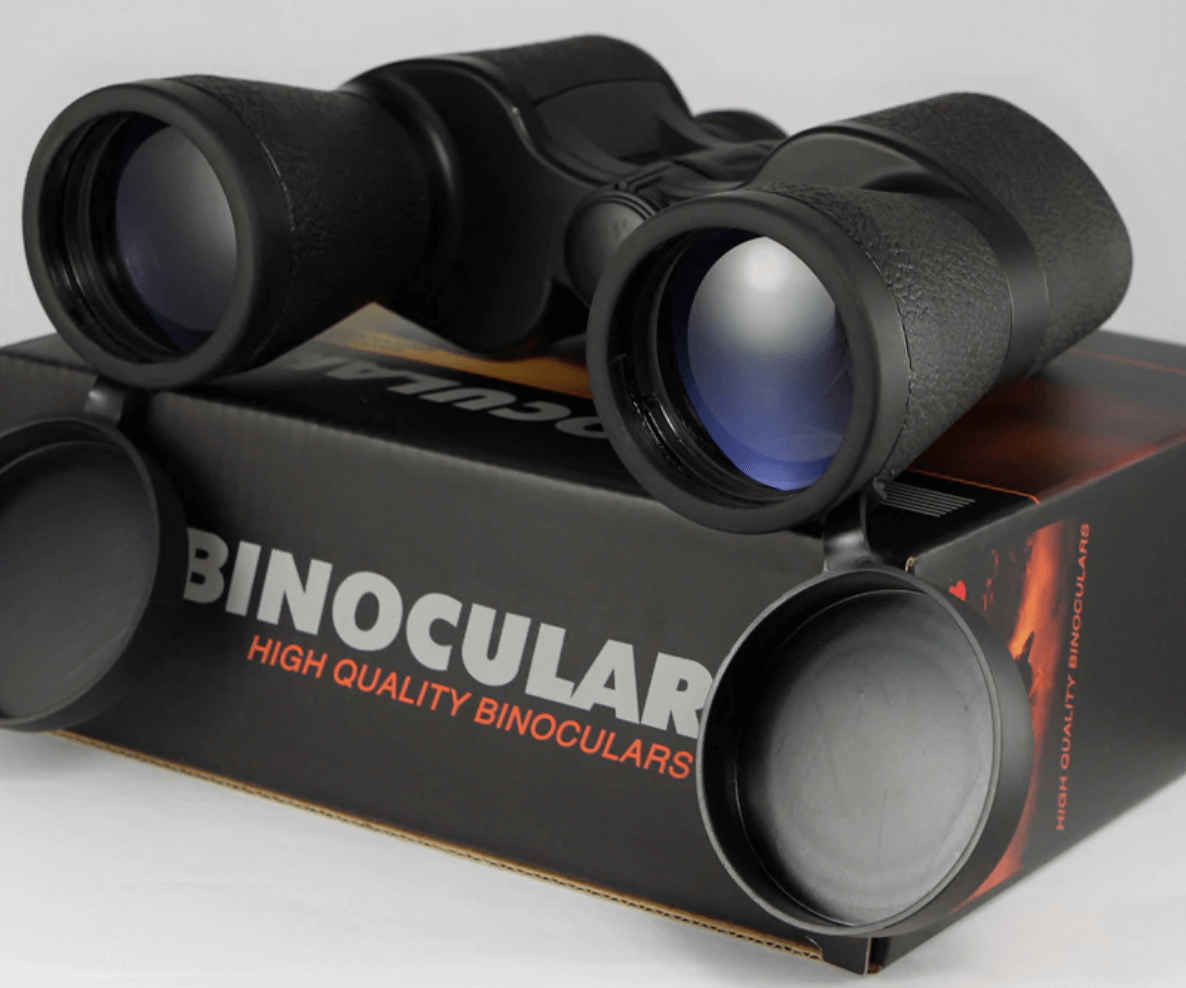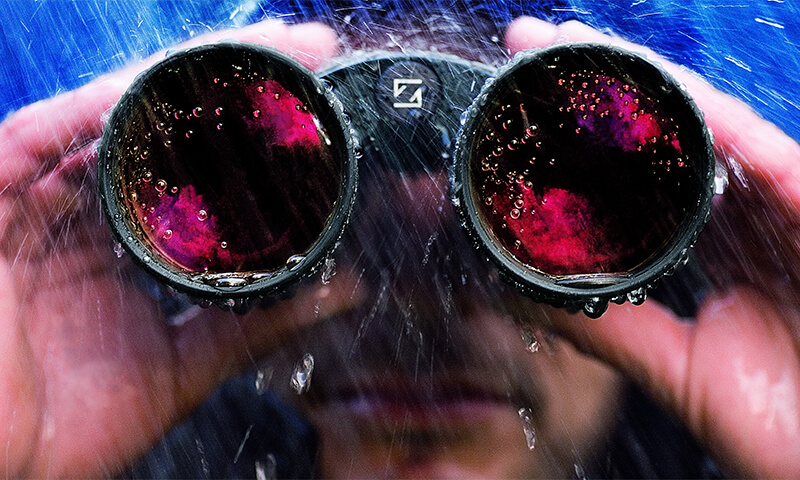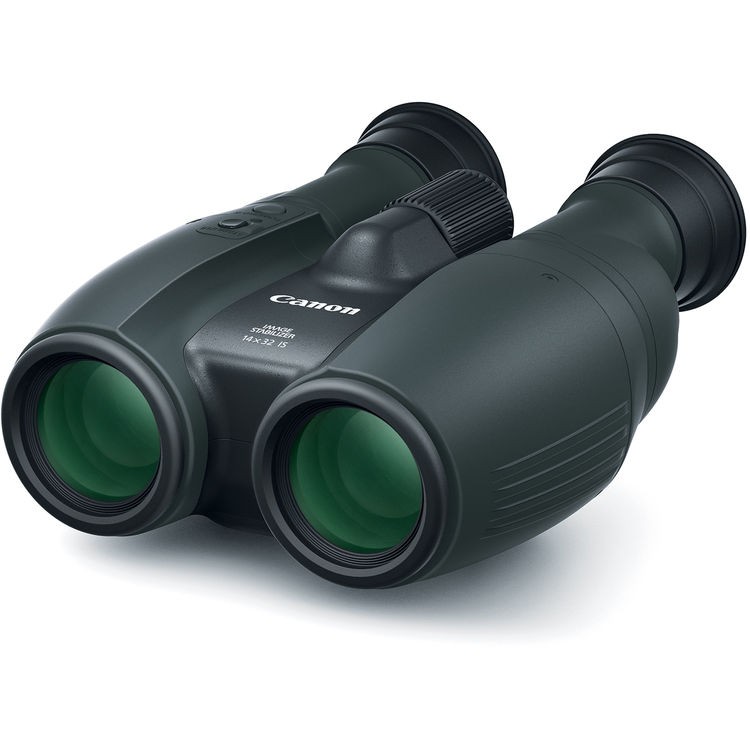How to Choose a Night Vision Device: Definitive Guide
Contents
- Pros and Cons of Night Vision Binoculars
- Pros of night vision binoculars:
- Cons of night vision binoculars:
- How Night Vision Devices Work
- How to Use Night Vision Devices Properly
- Types of Night Vision Devices
- What to Look for When Choosing Night Vision Binoculars?
- Other Night Vision Devices
- Binoculars with Rangefinder and Thermal Imager
- Best for Hunters
- Thermal Night Vision Devices
- Binoculars with Electronic-Optical Converters
- Digital Night Vision Binoculars
- Technical Characteristics of Night Vision Binoculars
- How to Choose the Right Device
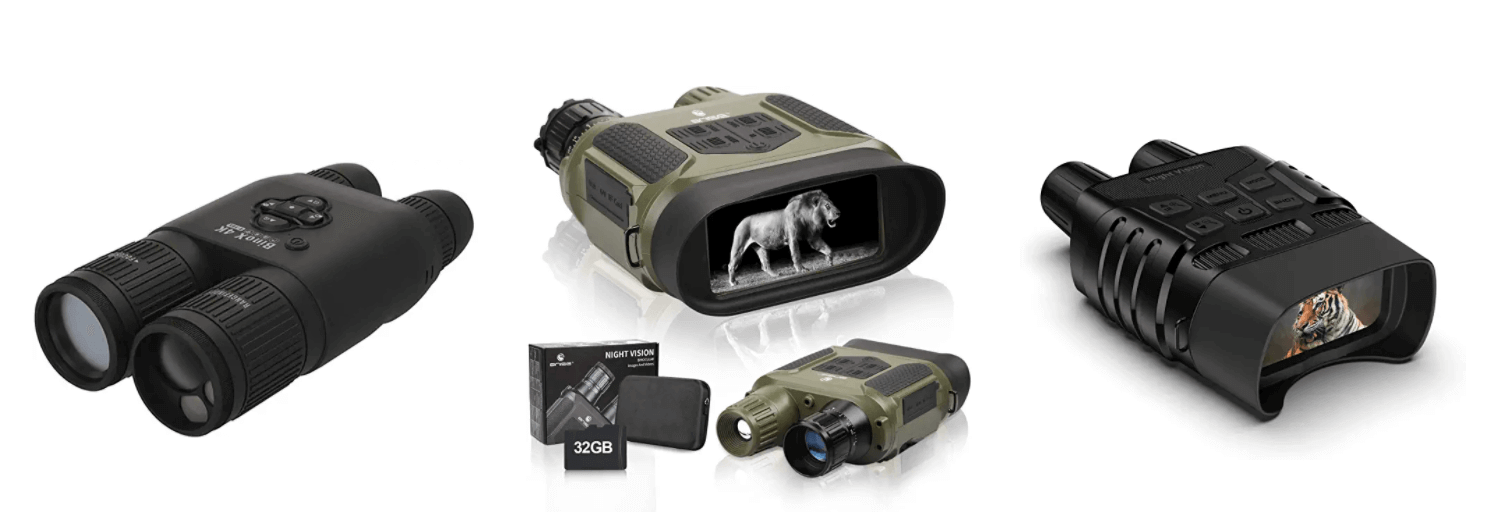
We are now witnessing a real revolution in instrument-making industry, including night vision binoculars.
The microelectronic element base is getting cheaper, and nanotechnology for manufacturing photosensitive elements is rapidly developing.
With modern night vision thermal imaging binoculars, you can not only track a deer over 2,000 meters, but also define the trophy value of the antler at distances over a kilometer.
Until the middle of the twentieth century, only a few birds and animals had the privilege of recognizing objects and seeing them in complete darkness.
But with the development of military technology, man finally got this opportunity.
Even before the start of World War II, German manufacturers were developing the first night vision devices, which worked through active illumination in the infrared range and image amplification with an electronic-optical image converter with a photocathode.
Prototypes were used in the tank forces and made it possible to safely move equipment at night without fear of the enemy.
To date, night vision devices (NVD) have been widely used in public life. They are actively used in rescue operations, aviation, navigation and even in especially extreme travel.
As for non-professional use, NVDs are often used by experienced hunters. And, despite the fact that even a modern device of the latest generations remains quite expensive, there are plenty of affordable models on the market that can give everyone the opportunity to actively participate in the nightlife of wildlife.
Devices with which you can increase visibility at night, make objects clear for study and observation, require a little more knowledge than just “plug and look”.
Initially, night vision devices (NVDs) were developed for defense purposes. This is understandable, because during military operations, the ability to act at night no worse than during the day can save many lives, and such devices have long been adopted by the armies of most countries of the world.
Night vision devices are electronic-optical devices based on an infrared image converter, which is placed in a protective case and equipped with a specific mounting system.
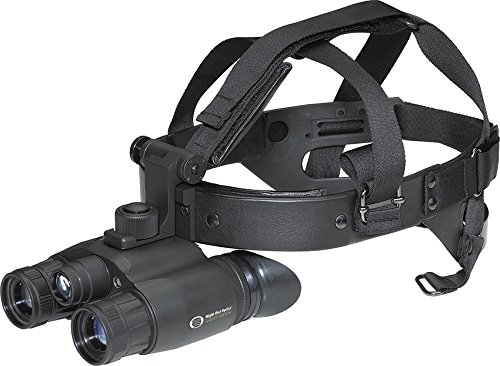
In addition, many night vision devices are equipped with infrared illumination and telescopic lenses. They come in the form of:
– Night vision monoculars
– Night vision binoculars
– Night vision scopes
– Night vision goggles
– Night attachments for optical scopes
– Night vision digital devices
The principle of functioning of night vision devices is significantly different.
Conventional optical night vision goggles and binoculars differ from night vision devices in that they are purely optical devices that allow you to see in low light conditions.
They only amplify the already existing light and form an image only by optical means due to objective lens of large diameter.
Previously, night vision devices were used primarily by the military and law enforcement agencies, but now they are increasingly used by ordinary citizens.
In the civilian field, they have found applications in night video and photography, night wildlife observation, maritime navigation and various security-related fields.
Recently, compact night vision devices have been installed on cars.
With night vision binoculars you can continue your outdoor activities even in late hours when sun goes down and you can continue your observations and enjoy the time. They are more advanced devices different from classic binoculars.
Especially they are preferred mostly by those traveling, hunting or doing hiking. All this becomes possible thanks to advanced infrared or thermal imaging technology.
Some infrared night vision binoculars can even record images and videos. Such binoculars are expensive, something around $300.
Pros and Cons of Night Vision Binoculars
There are some obvious pros of night vision binoculars that you must know before you decide why you choose such optical devices.
Pros of night vision binoculars:
- Ability to observe objects in extremely low light conditions
- Ability to quickly and easily identify objects/targets in the dark
- Ability to avoid potential dangers on your way
Cons of night vision binoculars:
- Night vision binoculars with advanced features are expensive
- Batteries sold separately
- Device is a little heavy due to batteries

How Night Vision Devices Work
If you do not go into all the details of the physics of the process, at first glance, everything looks quite simple.
A small amount of light, the source of which can be the moon, the starry sky, or natural illumination scattered in the clouds, one way or another, hits the object of observation in an open area and it reflects this light. The task of NVD is to collect and amplify the received light.
The light collected by the lens falls on a complex electronic-optical converter (EOC), the task of which is to receive an electrical signal from the photons, amplify it several thousand times and reproduce it again for the observer’s eyes.
With modern technology, the task is not difficult. The received signal is monochrome, that is, it has no colors, only shades.
It is usually reproduced in green tones. it is to this color that the retina is most sensitive.
But what to do in a situation when severe bad weather is raging, the sky is cloudy, or you just find yourself in a room completely isolated from the light?
Yes, everything is simple – you need to take care of the lighting yourself.
For this, many night vision devices are equipped with an infrared lamp that emits in the long wavelength range.
A person’s eye is absolutely insensitive to it, so you will remain unnoticed, even if you direct such a light directly into someone’s eye.
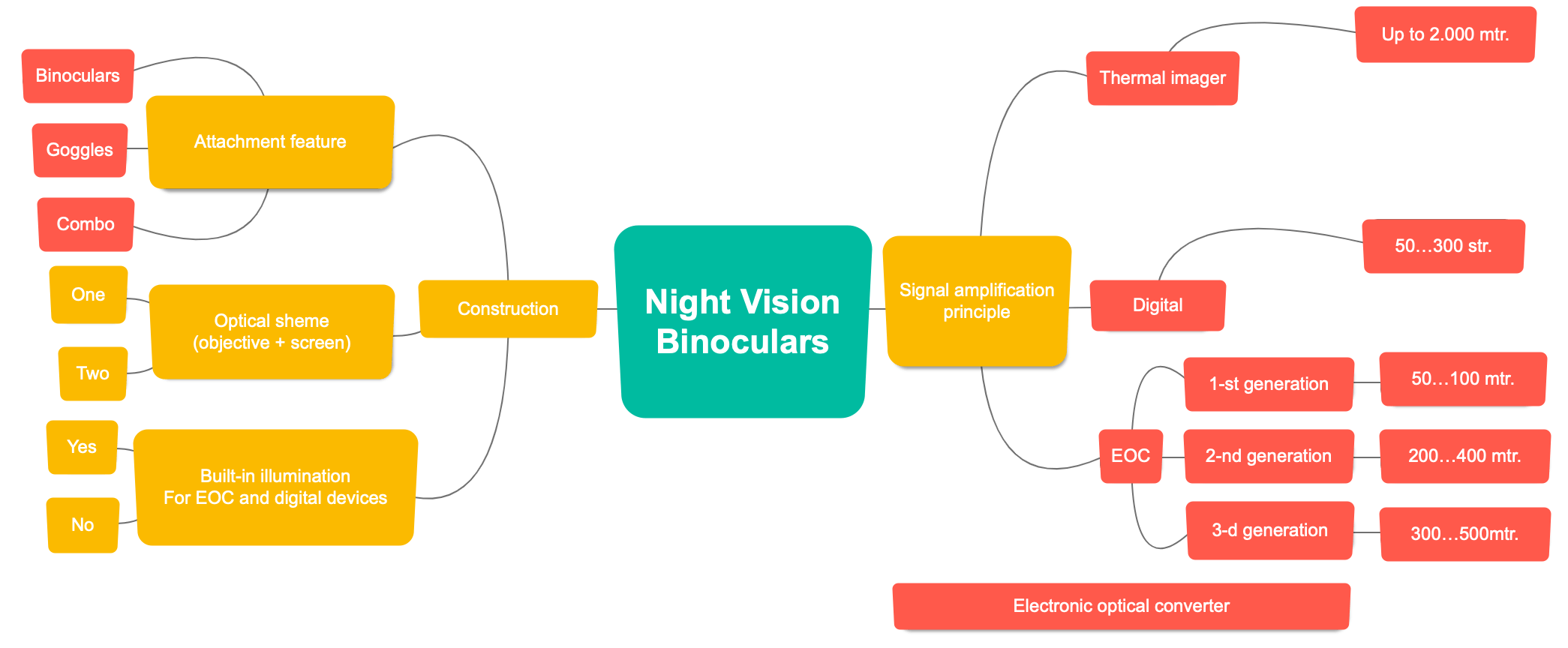
How to Use Night Vision Devices Properly
Before using night vision devices, you need to know a few things.
First of all, you need to protect your device from direct light because luminophore can burn out and sometimes it can even damage your device completely.
It can also cause image darkening or dark spots.
In short, follow these steps to protect your night vision device:
- Even if you don’t use your device, use lens caps during daytime
- Use your device only at night times because it’s a night vision device
- Don’t use it near other artificial lights including fire
Some new generation night vision devices can be used in daytime as well. They are expensive though.
Also, some new models have AGC (Automatic Gain Control) feature that automatically protects your night vision device from light exposure.
Ultimately, if you follow recommendations, it will increase the lifespan of your device.
Night vision device detection range is also different. The higher the magnification the higher is the detection range.
For example, magnification 1x has detection range up to 100m. Magnification 5x has detection range up to 350m.
Magnification 8x has detection range up to 550m.

Types of Night Vision Devices
There are different types of night vision devices available on the market.
Gen 1 – First generation. 1st generation night vision goggles are designed to operate efficiently within 200 meters, mostly in active mode (with Infrared illumination on). Basically, these are fairly simple tourist and amateur devices. These are the most affordable and commonly used by amateurs of optical devices, but they are not so effective. NVDs of the 1st generation are not protected from ambient light. Consequently, light from windows, streetlights, car headlights or a fire that falls into the field of view strongly illuminates the picture or even makes observations absolutely ineffective. 1 generation technology is used mostly in monoculars, rifle scopes, binoculars.
Gen 2 – Second generation. Second generation devices are effective at distances up to 600 meters. The use of this technology made it possible to get rid of the most serious problems of the 1st generation night vision devices. These devices are much less susceptible to side flare and still provide better image quality across the entire field of view. The main advantage of the second-generation devices is a better resolution. In practice, this means a sharper image, a greater viewing distance and the ability to see in extremely low light conditions. This type of night vision devices is preferred by experienced users for professional use especially for hunting or other outdoor activities.
Gen 3 and 4 – The main advantage of the third-generation night vision devices is their extremely high brightness gain. With the 3rd generation of night vision devices you can observe objects in the worst lighting conditions. Due to the high cost, this class of NVD is not available for general consumption. Usually it is used by soldiers of special forces or wealthy private hunters. These devices provide even better image quality, better battery life and suitable for long-range distances. These are devices that have incorporated all the achievements of modern technical thought. Gen 4 devices comes from ATN, Bushnell companies. Prices start from around $4.000 and up to $9.000.
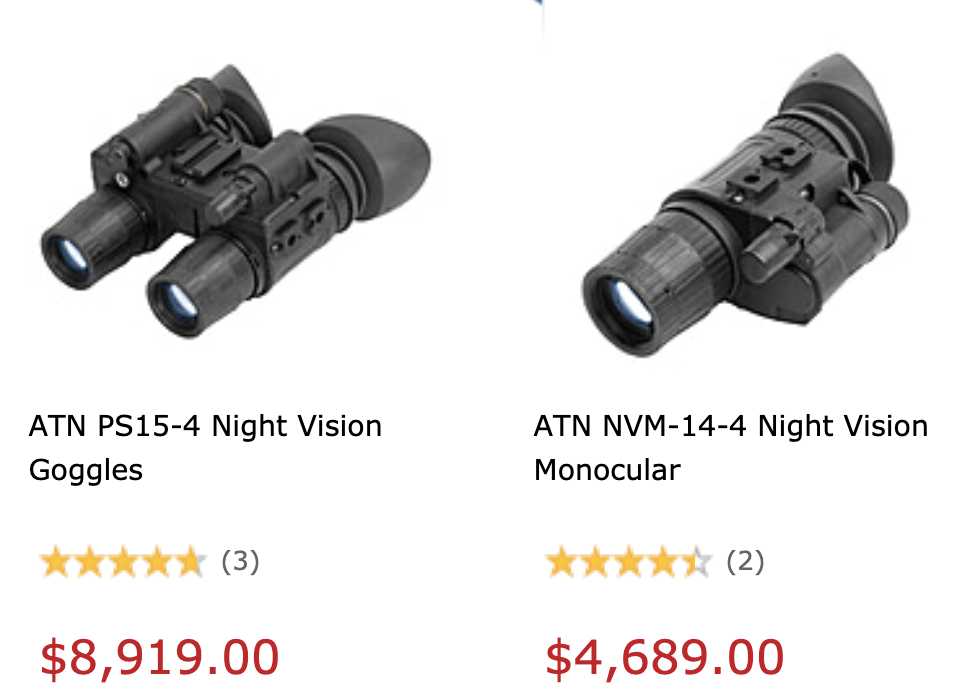
Reminder: Night vision binoculars is for identification and observation while thermal devices are for detection. With night vision device you can see faces and identify someone. With thermal device you can’t. You can only use it for detecting moving objects. With thermal night vision device, you can see objects even in a complete darkness, while with standard night vision device you can’t. With thermal device you can even hunt in a complete darkness.

What to Look for When Choosing Night Vision Binoculars?
If you plan to choose night vision binoculars you need to follow some simple steps.
First of all, if you define the purpose of use it will be much easier to make the right choice.
If you are on a tight budget you definitely should buy generation 1 night vision device.
The quality is acceptable and price is affordable. This is suitable for amateurs of optical devices.
If you plan to use it when hunting or other professional observations for outdoor activities you need to definitely choose generation 2 or 3 night vision binoculars or device. They are expensive, around $300 but worth the money.
Always remember that if you buy generation 2 and 3, such night vision binoculars normally have a powerful magnification, sharp and clear image, video HD and image recording feature and infrared illuminators to help you in complete darkness.
Such night vision binoculars will satisfy all your needs as a professional user or an optical device.
Also, before buying night vision binoculars or ordering it online make sure it’s not prohibited in your country. Some countries don’t allow this type of devices.
Make sure it’s weather-resistant because the device of generation 2 or 3 is expensive and it’s always better to buy one that is well protected from water penetration or even drops to avoid damage to your optical device.
But you shouldn’t much worry about this feature because generation 2 and 3 are normally protected from damage.
Generally speaking, night vision binoculars are suitable for multiple outdoor activities, such as general observations, hunting, traveling, camping, safaris, hiking, wildlife observations, fishing, home defense.
Some night vision binoculars have zoom feature with variable magnification power. As I said in my other articles about zoom binoculars, zoom feature is not so good when it comes image quality and field of view.
It’s always better to choose a device with a fixed magnification.
For hunting purposes, you probably need night vision binoculars with a rangefinder feature to be able to know the distance between you and your observed target.
Night vision binoculars or device with infrared illumination gives much better image and increases your observation ability.
Below you can see two images, one without infrared and second one without infrared.
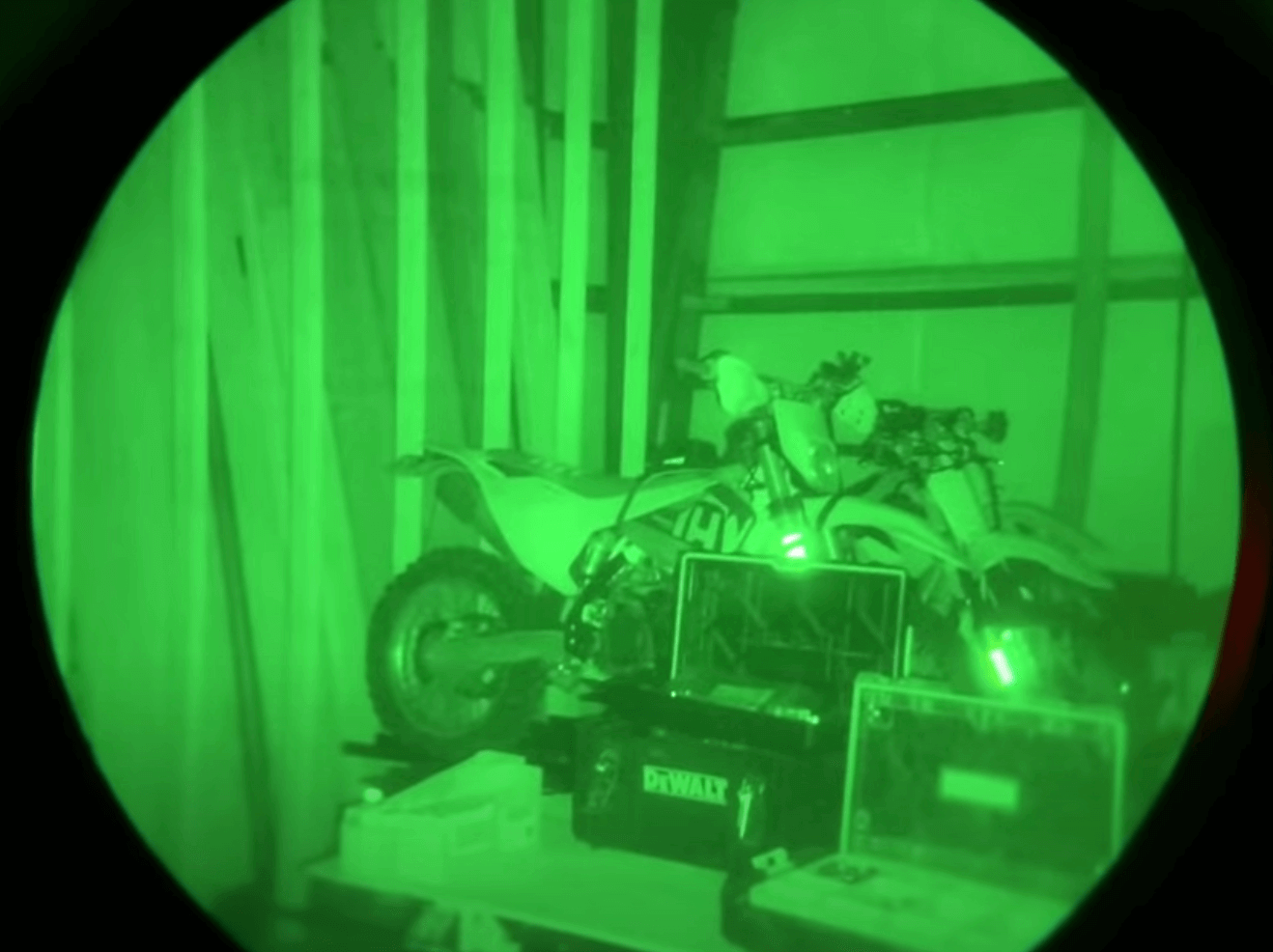
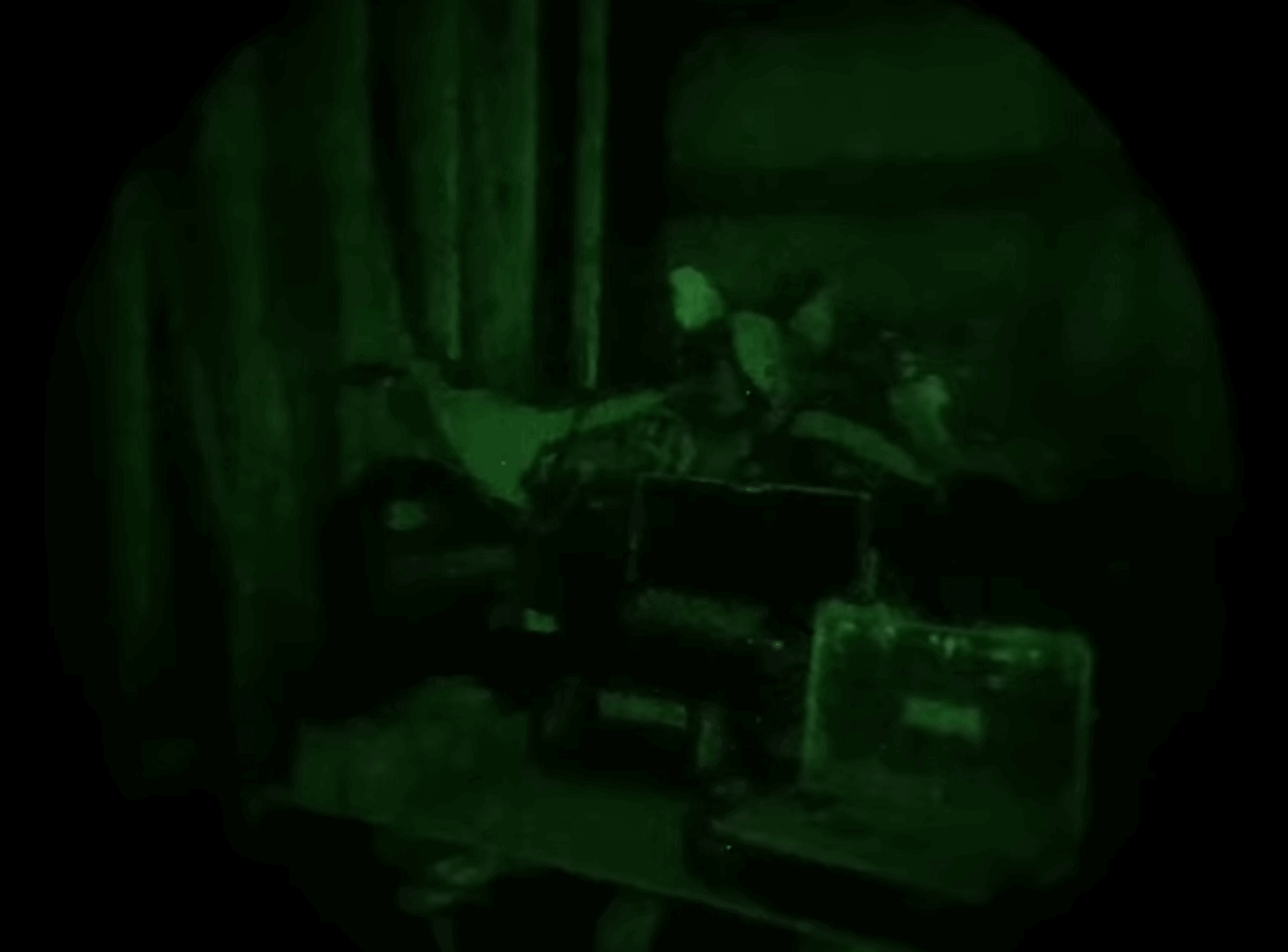
If you have eye astigmatism problem you should choose night vision binoculars with eye relief of at least 18mm.
When buying NVD, give preference to well-known companies with extensive experience in production of high-quality night vision devices and who provide warranty and post-warranty service for their devices.
With night vision binoculars or device with a thermal imager or infrared illumination you can observe, detect or even hunt in a complete darkness.
See the images below to understand the difference between night vision and thermal imager.
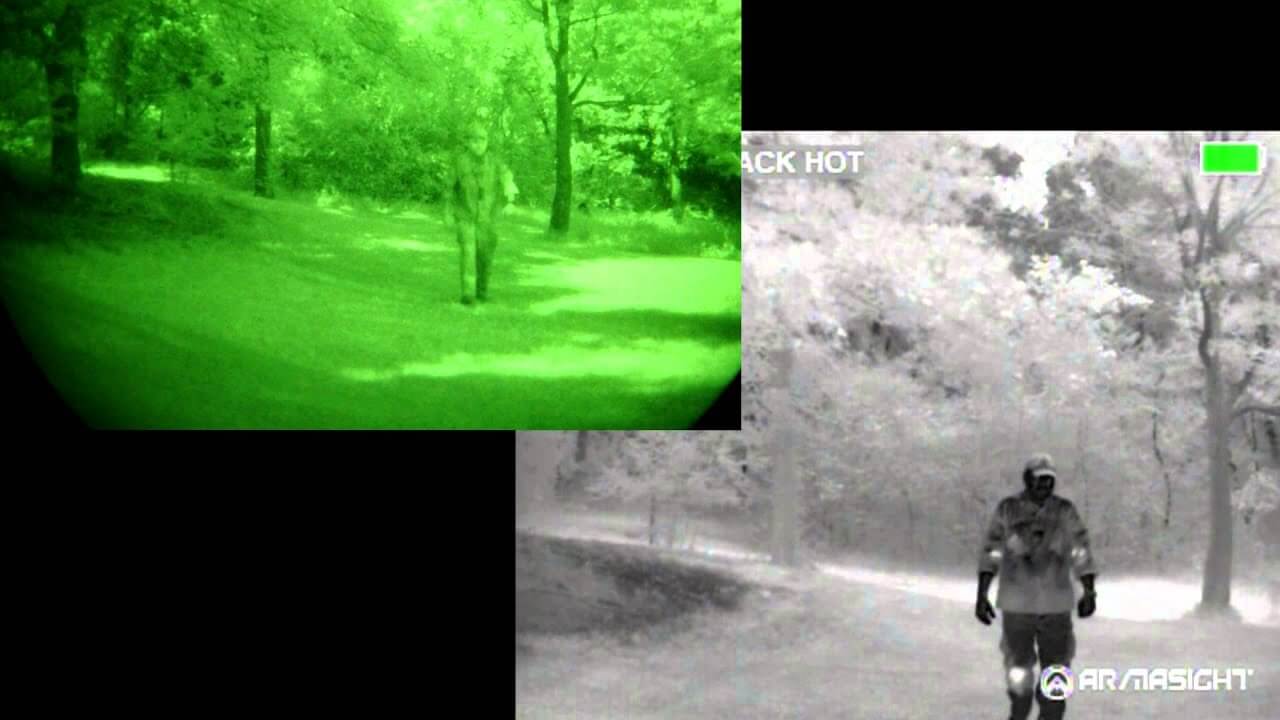
Other Night Vision Devices
There are some other night vision devices available on the market, such as night vision monoculars, night vision goggles, night vision scopes.
Night vision monoculars are often used as rifle scopes that can be mounted onto a weapon. These devices are used by hunters.
Using them instead of binoculars is not recommended because it’s a single eye device which is unnatural for human eyes.
You will do much better with night vision binoculars instead. Night vision rifle scopes vary from $2.000 and up to $6.000.
Night vision goggles is a device that has no magnification and mounted on your head.
There are two types of goggles, two eye-piece with a single image tube and two eye-piece with a dual image tube.
Dual tube night vision goggles provide stereo vision that gives you better image depth.
This device is just for walking or observation in a complete darkness without magnification feature.
There are different generations of night vision goggles available, such gen 1, gen 2, gen 3, gen 3+, gen 3p and gen 4. Prices vary from $2.300 and up to $7.999.
Almost all night vision devices can be divided into 6 main types: monoculars, binoculars, goggles, scopes, attachments, digital night vision devices. Some are intended solely for target detection others for observation like monoculars, binoculars.
They are better suited for orientation on the terrain, protection of territories, search and rescue of people.
But even when hunting, these devices can be extremely useful. Especially if you conduct observation from a hunting tower or any other ambush and report the location of the detected animal to your comrades who have the necessary sights that will allow you to make an accurate shot even in complete darkness.
A better choice for night hunting will be independent night vision scopes and attachments for daytime optical sights.
These devices will allow not only to detect the target, but also to keep it in sight at the moment of the shot.
The attachments are installed with the help of special adapters in front of the daytime optical sight, as a result of which the hunter receives a whole sighting system that allows him to detect and hit the target in the dark.
The attachments will be an excellent choice for those who already have a good optical sight in their arsenal with the ability to work in conjunction with NVD (night vision device).
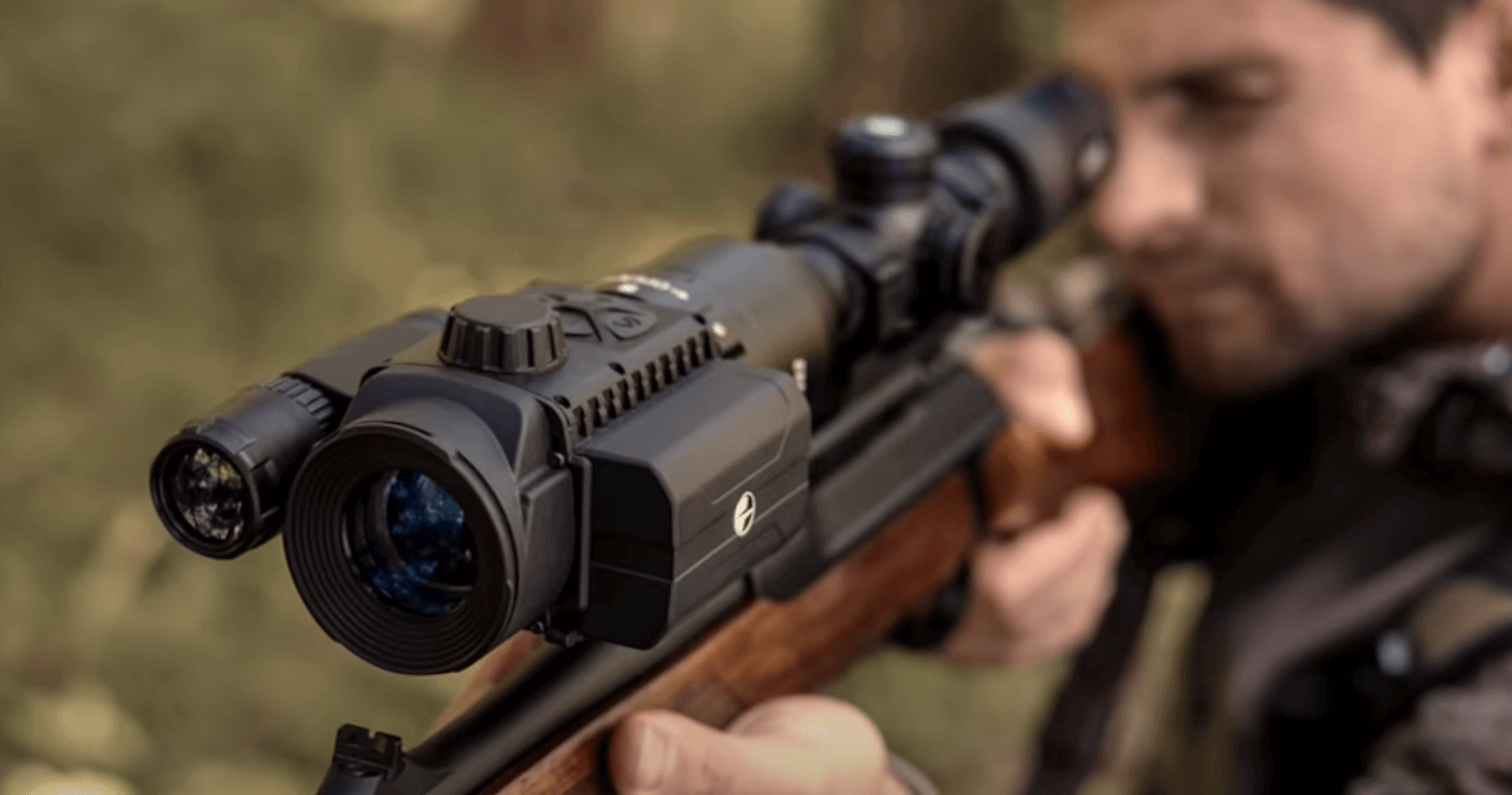
Let’s talk about the features, advantages and disadvantages of night vision attachments. Advantages: the attachments are compact, they almost do not affect the overall ergonomics of the weapon and are often cheaper than independent night vision scopes.
Another advantage is the ability to quickly install and remove, which allows you to switch between an optical sight and a night vision device in a matter of minutes when needed.
In the case of a night vision scope, you will have to dismantle one device and reinstall the second, most often performing additional aiming of each scope.
Now about the disadvantages: of course, the attachments are suitable only for those who already have good optics, in any other case they will be of little use.
It should also be noted that when purchasing a night attachment, you may need to purchase additional accessories for it in order to properly install the new device directly on your optical sight.
And of course, most night vision devices, and this applies not only to attachments, are afraid of sunlight.
Devices operating on the basis of electro-optical converters are highly recommended to use only in night times, although there are day / night class devices on the market, which we will talk about a little later.
A little more about the features: most often, night vision attachments do not have optical zoom, since your optical sight is responsible for this feature.
What should you look for in order to choose the right night vision scope? First of all, this is the type of sensor, on which the target detection range and the quality of the resulting image will depend.
These can be electronic-optical converters of various generations (which are less and less in demand every year due to their displacement by new technologies) and new advanced technologies which are often used in digital night vision scopes, as well as in day-night devices.
On average, a good night vision scope provides the user with a target detection distance of 450-500 meters.
This is more than enough for night hunting, as most often you have to get much closer to the target in order to increase the chances of a successful shot.

You should also pay attention to the presence of a built-in infrared illuminator or the possibility of installing it as an additional accessory.
This is a very important component of any night vision device, since the IR illuminator, firstly, allows using the device in absolute darkness, and secondly, it significantly increases the observation distance.
So, don’t ignore the presence or absence of this useful addition to your scope.
Another important indicator is the optical component of your device, which is responsible for optical magnification, focusing distance and field of view.
When it comes to digital night vision devices, also look out for digital zoom, which complements optical zoom perfectly.
Digital devices are not for hunting or observation. They are used mostly for security reasons or patrolling areas.
For this purpose, you don’t need magnification power used in binoculars.
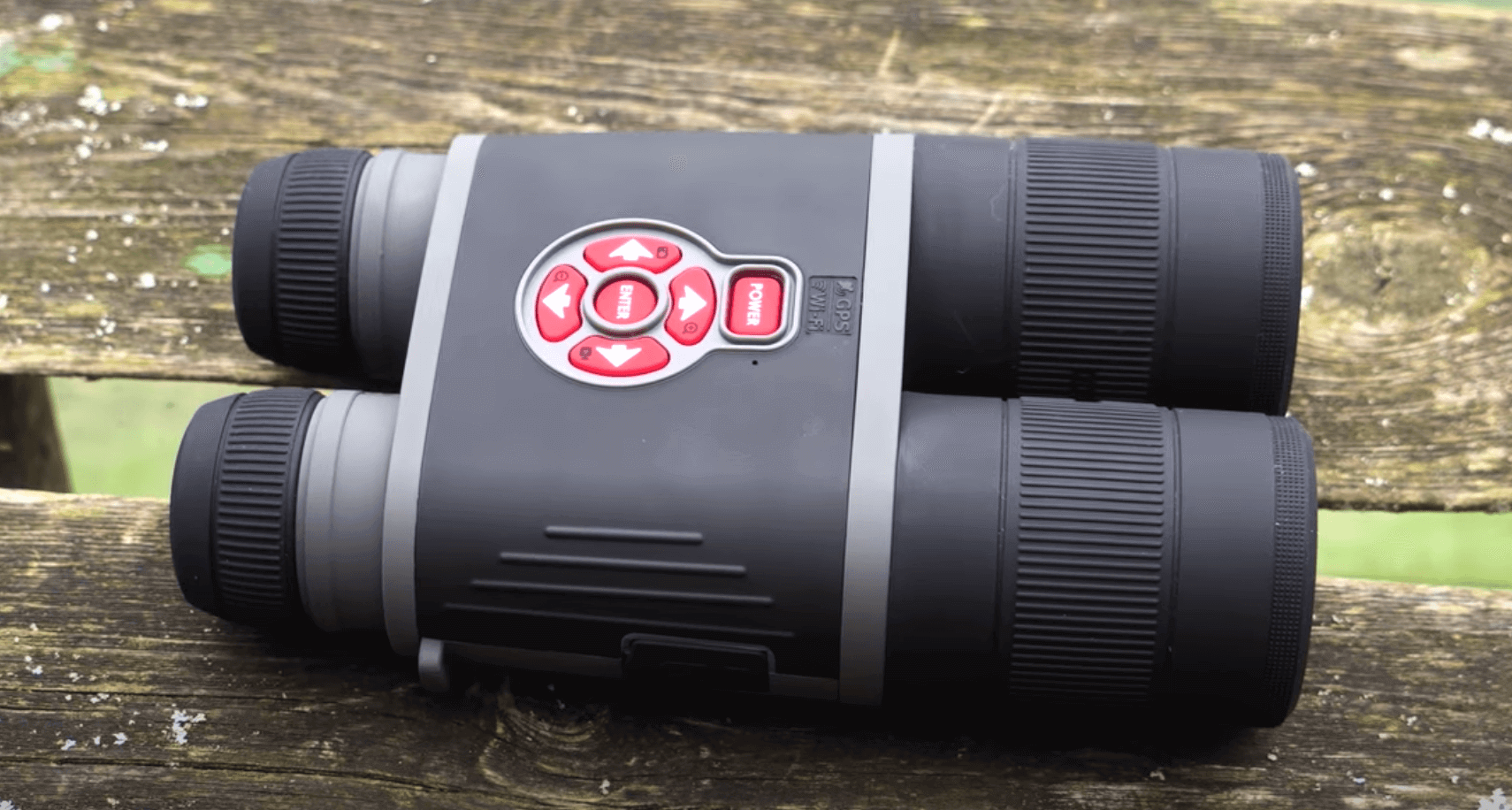
Binoculars with Rangefinder and Thermal Imager
Night vision binoculars with a thermal imager are one of the best companions for night hunting.
This device detects the level of thermal radiation from objects and converts it into light waves that are visible to human eyes.
Objects vary in glow level and are clearly delineated. With “night thermal imager” binoculars everything is clearly visible: animals, trees, stones, fences, cars and much more.
The undoubted advantage of a thermal imaging device is its immunity to spot illumination.
With such binoculars, you can safely look at objects located near lanterns, bonfires and other sources of bright light. Such elements of the environment do not impair the general visibility.
But looking at them directly is still undesirable – you can damage the internal circuits of your binoculars. In any case, before such experiments, it is better to read recommendations of the manufacturer of the optical device.
The main competitor of a night vision device with a thermal imager is the classic night vision device with an electronic-optical converter.
It works on a different principle and, unfortunately, requires additional InfraRed illumination.
Everything would be fine, such an illuminator is easy to install, but many animals are able to see the source of IR illumination. The beast is frightened, the hunt fails. Night vision binoculars also have problems displaying objects that are behind small obstacles.
A night vision device will not show a wild boar hiding in tall grass, but this will not be a problem for a thermal imager.
Therefore, for night hunting, an optical device with a thermal imager – a monocular, rifle scope or binoculars – is a WAY more effective device. An example of this can be seen on two images below.
One is a night vision device with infrared illuminator and the other one is a night vision device with thermal imaging feature.
One that has a thermal imaging feature animal can be easily spotted while with a standard night vision device it becomes a challenge.
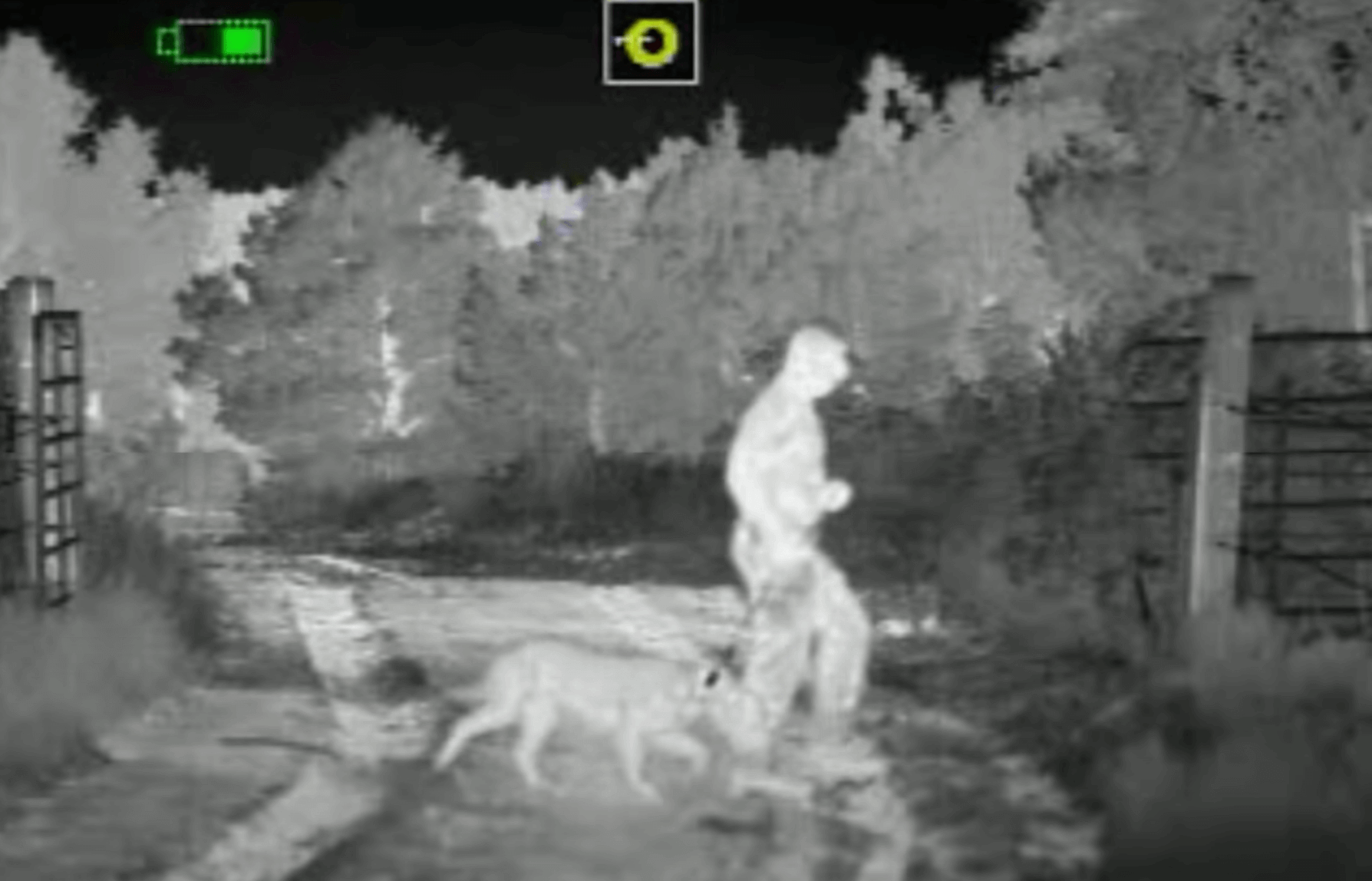
Are there binoculars with classic night vision and thermal imaging? No, both technologies are not installed in optical devices at the same time.
Are there any restrictions on the use of built-in thermal imagers? There are no serious ones.
However, these devices do not like high humidity. The water covers the objects of observation and reduces the level of their thermal radiation. Rain, fog, snow – these are all unfavorable conditions for observation. But at the same time, not fatal. The thermal imager also does not “see” through glass, but it perfectly recognizes objects in the daytime.
Best for Hunters
The best choice for any hunt is binoculars with a rangefinder and a thermal imager.
Such an optical device will allow you to quickly calculate the distance to the object of observation and take into account all the nuances to make the perfect shot.
Unfortunately, such optical devices are difficult to manufacture and expensive.
Purchasing a separate rangefinder that is not installed in binoculars may be a compromise.
With a thermal imager, there are not only binoculars, but also monoculars.
The principle of their work is the same, the only difference is in the design.
Binoculars are more convenient for long-term observations, monoculars are lighter, more compact and perfect for short-term study of night surroundings.
![]()
It is often much more pleasant to use a monocular when hunting at night, but this is a matter of preference.
Digital night vision devices are a good alternative to thermal imaging devices.
This is a modern development for observations in dark rooms and at night, which, due to the device specifications can also be used for daytime observations.
As a hunter remember that thermal imaging device is for target detection purposes, not for observation.
For observation purposes you can choose electronic optical device with converter that has IR illuminator.
This device can be used for observation even in a complete darkness.
Thermal Night Vision Devices
The most modern night vision devices are thermal imaging devices. Without going into the principle of operation and differences between thermal imagers and other night vision devices, we briefly note that:
The detection range of a full-length human figure is up to 2 kilometers
It allows you to observe the thermal radiation of objects at night in the complete absence of even the slightest light and in the daytime
Cost – from $200 up to $900
Thermal night vision devices are the best solution for observing in the dark in all conditions. Most often it is used to guard territories (when it is important to be the first to see violators), to track down wild animals, in sea navigation.
They are very effective and durable compared to electronic-optical converters. But the image quality is not so good compared to electronic-optical converters.
Thermal night vision devices are for detection purposes, not for observation.
Binoculars with Electronic-Optical Converters
Binoculars with electronic-optical converter of the 3rd generation (the most perfect) in the moonlight, illuminated clouds or in the snow can distinguish a human figure up to 600 meters.
On a moonless night on a plowed field – up to 300 meters. In the forest, even less.
They cannot see during the day and, despite being protected from light exposure, can get out of order because of a bright light. But they also have their advantages:
- Simplicity and reliability of the electronic circuit
- Significantly lower battery consumption (in comparison with thermal and digital cameras), powered by one or two AA batteries.
- Compactness
Binoculars with electronic-optical converter of generation 1 and 1+, even with the use of built-in or external IR illumination, a person can be seen up to 150 meters.
At the same time, such a distance is often enough for guarding small objects or tracking down an animal from an ambush: for bait. They can also be used as night goggles. See images below as night vision binoculars work in a complete darkness.
These simple, reliable and inexpensive night vision binoculars are the choice of most hunters.
This is due primarily to the duration of uninterrupted operation from batteries: one battery with economical use can be enough for a week!
It should be noted that binoculars with electronic-optical converter of the 1st generation, although they have a low cost, are inferior to digital night vision binoculars.
In the near future, all brands, including the popular Yukon (aka Pulsar) in the post-Soviet space, are likely to stop producing them.
Binoculars with electronic-optical converter and Infrared illumination are perfect for night observations even in complete darkness.

Digital Night Vision Binoculars
The detection range of a human figure in digital night vision binoculars is comparable to binoculars with electronic-optical converter 1+ generation.
However, the image at a short distance will be much more contrasting: you can see whether a person is armed or not, to distinguish friend or foe.
These devices are highly dependent on external light and most often work with built-in IR illumination, and the detection range is limited by the power of the illuminator.
IR illumination can be detected with another night vision device and even on a smartphone camera. The advantages of digital night vision devices include:
- High image contrast
- Low cost
- Maintainability
- Affordability
- Ability to observe objects on the digital screen
Technical Characteristics of Night Vision Binoculars
Choosing the right night vision binoculars does not require any engineering education or deep understanding of the details of the device. But a little understanding of the technical characteristics is necessary. Some of them are related to electronic-optical converters, and some are related to the binoculars themselves. Here are the main ones, in simple terms:
Binoculars with electronic-optical converters have a different power. It can be from 500 for simple models and up to 50 thousand for the most advanced models. It shows how many times visible light is amplified by the device. The more, the better, but the cost can vary several times.
Image resolution is the clarity of the visible image (the ability of the device to reproduce the image of closely located objects). Measured in lines per millimeter. It can reach a value of 65-70. An important parameter, but it should not be overestimated – in practice, a resolution of 35-40 / mm is sufficient.
Integral sensitivity of the photocathode. A calculated value that determines how much current is generated by the light. It is measured in amperes per watt, but in practice it is completely invisible to the consumer. A device with a lower sensitivity may, under certain conditions, show better results than a higher one.
Lens size. The ability of optics to collect weak light depends on its diameter. The larger the lens, the higher the aperture ratio.
Magnification of the device. In optical binoculars, the magnification is the ratio of the focal lens to the eyepiece. But the night vision devices show the image formed in the electronic-optical converter – it is like looking at a television screen through a magnifying lens. Therefore, only the magnification of the lens matters to the hunter.
Weight. If every gram counts, it makes sense to choose the lightest device. But ultralight and compact models, all other things being equal, are more expensive.
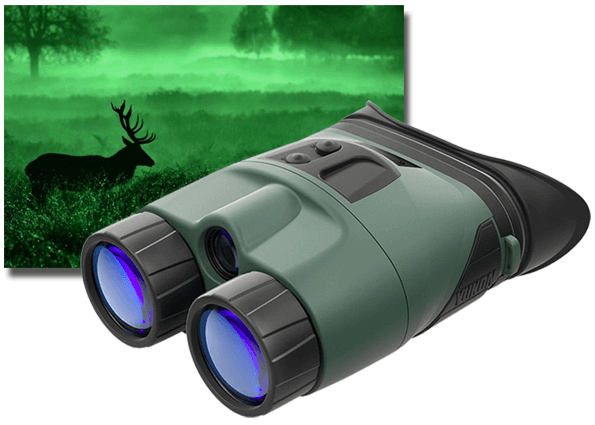
How to Choose the Right Device
For the hunter, the effectiveness of equipment is, first of all, successful trophies obtained in the forest. No technical characteristics of binoculars, its generation or brand can guarantee the result.
We can say that the owners of smooth-bore weapons, whose aiming range rarely exceeds 75 – 100 m, can do well with binoculars with electronic-optical converter of generation I +.
But hunting and stalking a beast are two different things. Therefore, owners of more advanced binoculars with an observation range of 300-500 meters will benefit.
If you are hunting with rifled weapons at sniper ranges, it makes sense to think about more expensive night vision binoculars of third-generation.
In short, it’s difficult to find a type of device that would be perfect for all types of tasks. First, you have to decide the purpose of your buy and then make the right choice.
For general purposes night vision devices with infrared illuminator will satisfy your needs.
Night vision devices with infrared illuminators are for identification and observation while thermal imagers are for detection, hunting purposes.




